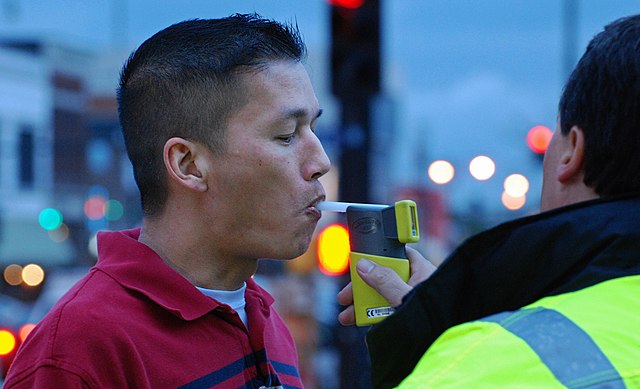
How does a breathalyzer work? The alcohol in a person’s breath reacts with a solution, creating an electrical current.
The breathalyzer relies on the fact that when you drink alcohol, some of it gets into your lungs and you breathe it out. That’s why, when you take a late bus home on a Friday night, you can smell all of the people that have been drinking. If you drink an alcoholic drink, the alcohol and the water in the drink will go straight down into your stomach. 20% of the drink will be absorbed directly through your stomach wall and the rest will pass on to the small intestine where it will be absorbed. The water and the alcohol will go into the bloodstream and very rapidly pass around the body. It takes about 30 seconds for the alcohol to reach the brain. The alcohol causes the blood vessels to widen, which is why your face goes red and you feel warm when you drink. The alcohol goes to the brain, causing slurring, loss of balance, and all the other things associated with being drunk. The alcohol goes to the liver where it is metabolized and removed from the body. The liver can metabolize roughly one unit of alcohol per hour. One unit of alcohol is one shot of spirits, or half a pint of low strength beer.
The liver can only remove one unit of alcohol an hour and the more you drink, the more alcohol builds up in your bloodstream. When the police stop someone who is drunk driving, the amount of alcohol still in their body is what they want to know. That can only be accurately done with a blood test, but a rough estimation can be made using a breathalyzer. The alcohol you drank circulates all around the body and passes through the lungs. The lungs remove carbon dioxide from the blood and some of the alcohol evaporates through the lungs at the same time. We breathe that alcohol vapor out. That’s why you can smell when someone has been drinking. This small amount of evaporated alcohol is what the breathalyzer detects.
It is possible to calculate the appropriate blood alcohol level from the breath because of something called Henry’s Law. A physicist called William Henry in 1803 discovered that if a gas and a liquid are in a closed container (the body), at a constant temperature, and in a state of equilibrium, the concentration of the gas in the air above the liquid is proportional to the concentration of the gas which is dissolved in the liquid. The ratio between the amount of alcohol in the breath and in the blood is 1:2100, although this is heavily disputed.
When you breathe into a breathalyzer, the air passes through sulfuric acid, which removes the alcohol into a liquid. This liquid then reacts with potassium dichromate and sliver nitrate. (The nitrate is added to make the reaction happen faster). The potassium dichromate is a reddish-brown color. If there is alcohol in the liquid, the potassium dichromate reacts and changes into chromium sulfate potassium sulfate acetic acid water, which is green. The more alcohol there is in the breath, and subsequently in the alcohol liquid, the greener the chromium becomes. The device has another section with unreacted potassium dichromate and it can compare the differences in color between the two liquids using a photocell. This gives off an electrical signal, which is translated into a readout. The color the chromium changes is directly proportional to the amount of alcohol in the breath, which is directly proportional to the amount of alcohol in the blood. The system is not 100% accurate, but it does give a good idea. If you are caught drunk driving, the police will take you back to the police station and try to get a blood test, which is accurate.
The modern breathalyzer was invented in 1958 by Robert Frank Borkenstein, who was an inventor. Before the breathalyzer, there was an invention called the Drunkometer, which involved drivers blowing into a balloon, which was then treated with a chemical that darkened in the presence of alcohol. It worked, but it was pretty bulky and difficult to use. Interestingly, the idea of drunk driving only really appeared after the end of prohibition in America and as more and more people owned cars. Today there are more cars on the road than ever before and technology is improving in leaps and bounds, but the amount of drunk driving is not decreasing. In 2021, 13,384 people were killed in alcohol related traffic accidents, which is 37 people every day. And this is what I learned today.
Image By KOMUnews – https://www.flickr.com/photos/komunews/8684229367/in/set-72157633361076430, CC BY 2.0, https://commons.wikimedia.org/w/index.php?curid=39636604
Sources
https://www.nhtsa.gov/risky-driving/drunk-driving
https://blog.history.in.gov/tag/drunkometer/
https://www.medicalnewstoday.com/articles/breathalyzer-test#how-it-works
https://en.wikipedia.org/wiki/Henry%27s_law
https://www.hg.org/legal-articles/dui-law-general-theory-of-breath-testing-6235
https://www.nidirect.gov.uk/articles/what-happens-when-you-drink-alcohol
https://www.nhs.uk/live-well/alcohol-advice/calculating-alcohol-units/
https://www.mcgill.ca/oss/article/did-you-know-history/breathalyzer-there-was-drunkometer
https://electronics.howstuffworks.com/gadgets/automotive/breathalyzer.htm
